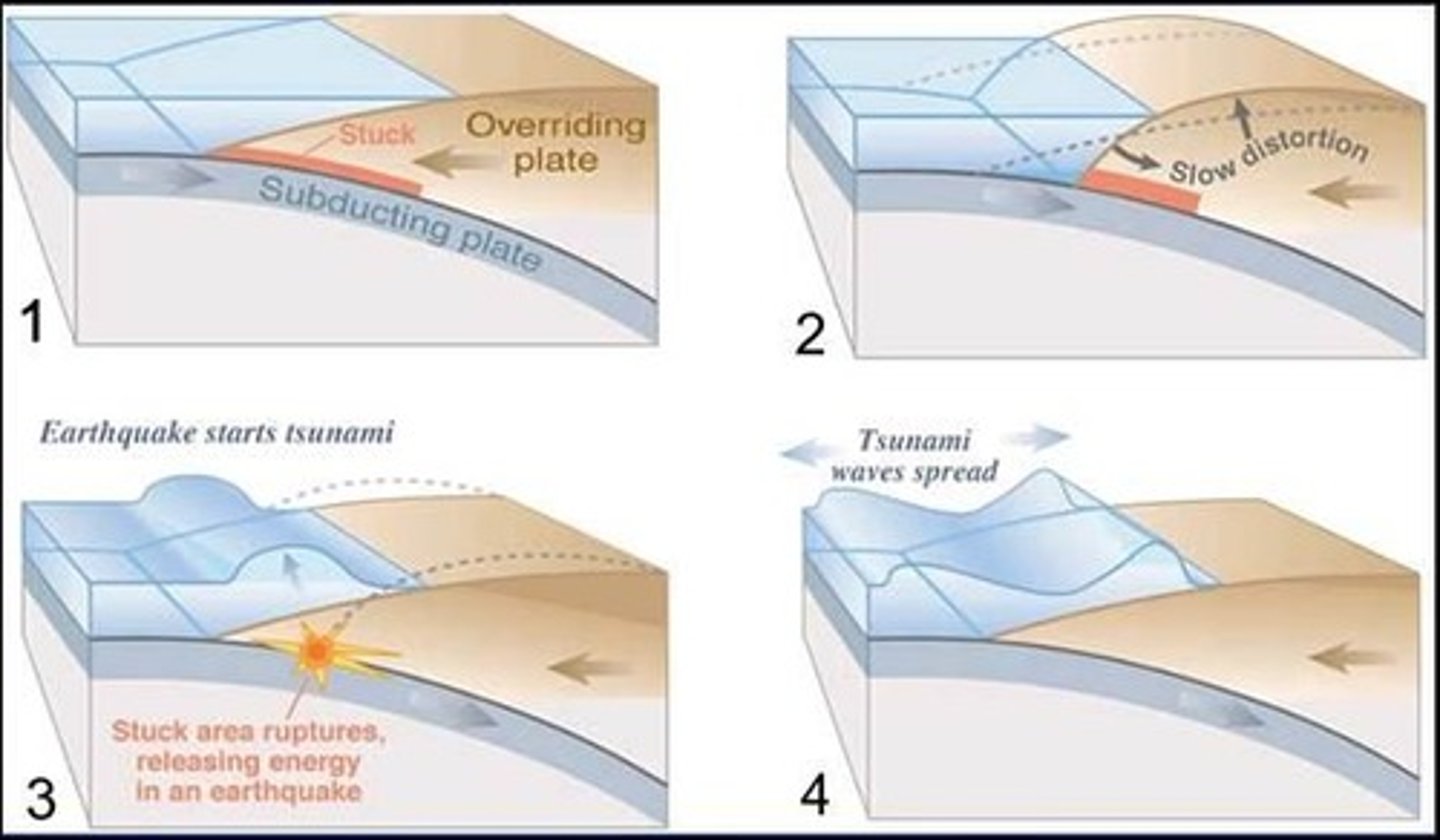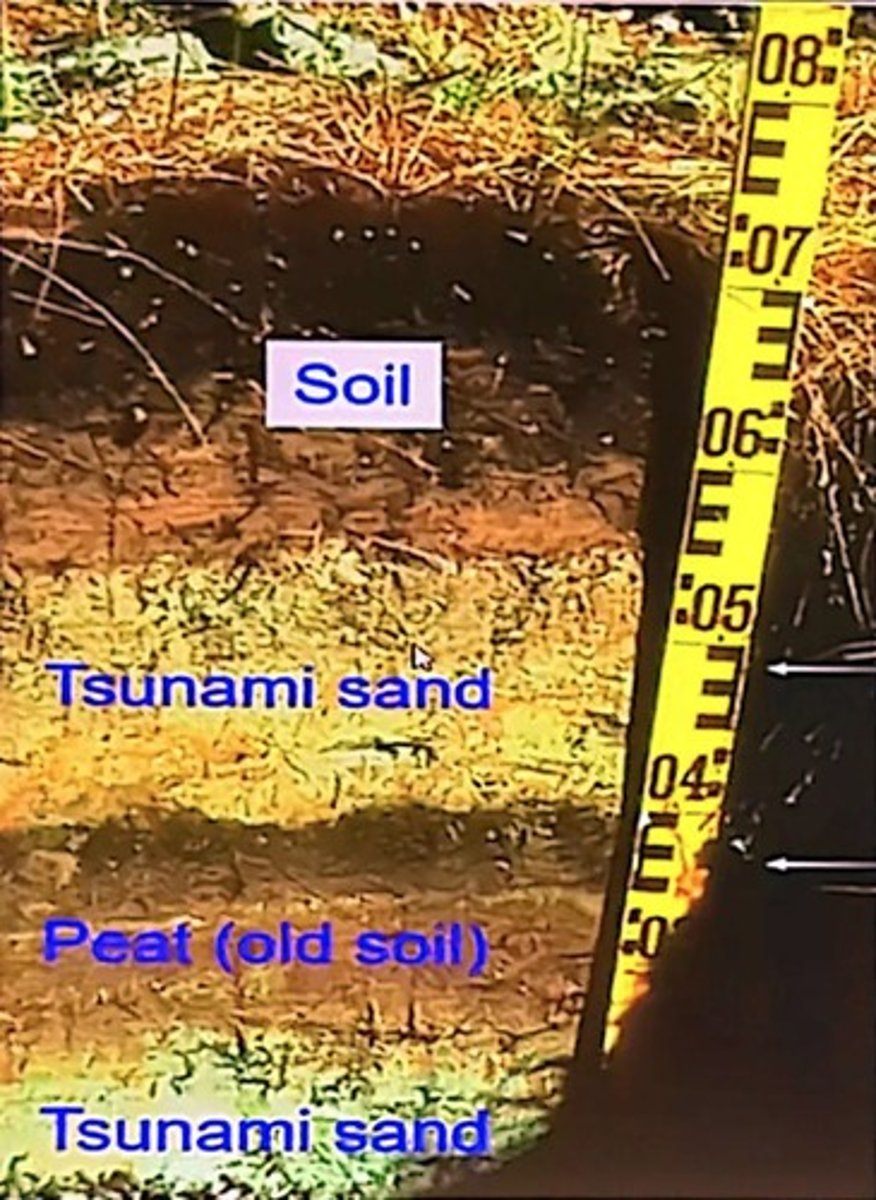Comprehensive Geosciences in Movies: Tsunamis, Volcanoes, and Catastrophes
1/68
There's no tags or description
Looks like no tags are added yet.
Name | Mastery | Learn | Test | Matching | Spaced |
|---|
No study sessions yet.
69 Terms
Subduction zone earthquakes
The most common means of generating a tsunami is elastic rebound during a large subduction zone earthquake.

Tsunami generation
Anything that can displace a huge volume of water vertically can cause a tsunami.
Wind-blown waves
have short wavelengths, brief periods, and no additional water mass behind the wave front.
Tsunami characteristics
Tsunamis may not be taller than the wind-blown waves, but they have a long wavelength, and a large water mass builds up behind the wave front.
Tsunami in deep water
Tsunamis in _ water are shorter in wave height, longer in wavelength, and faster.
Tsunami in shallow water
Tsunamis in _ water are taller in wave height, shorter in wavelength, and slower.
Water wave breaking
Water waves will typically break when the wave height equals the water depth.
Earthquakes causing tsunamis
Earthquakes along convergent plate boundaries with magnitudes 7.0 or over can cause tsunamis because they displace large amounts of water vertically from subduction zones.
Transform plate boundaries
Transform plate boundaries can't cause tsunamis.
Swimming and tsunamis
Being a good swimmer isn't enough because the amount of debris and the force of the debris and waves can easily injure people in the tsunami's path.
Tsunami stones in Japan
In Japan, dozens of tsunami stones were planted along its coast to warn residents not to build below them; some of these stones are 600 years old.
Sand deposits
Sand deposits indicate past tsunamis along the Washington/Oregon coast.

Tsunami fatalities
Several hundred thousand people have been killed by tsunamis in the past 1000 years.
Seismic shaking near shore
Significant seismic shaking near the shore means you have 20-40 minutes to head to high ground before a tsunami hits.
Sea level drop before tsunami
The wave trough often arrives before the wave crest.
Danger of returning after tsunami
Tsunamis consist of multiple waves, and the 2nd and 3rd are the most powerful because the energy from the previous wave contributes to the 2nd and 3rd.
2004 Indian Ocean tsunami
Many people died around the Indian Ocean due to the 2004 tsunami.
DART tsunami early warning system
Sends tsunami warnings 15 minutes after an earthquake, including the path and size estimates.
Sensors on the seafloor
Measure water pressure, and the measurements are sent by acoustic signal to a buoy.
Buoy
Sends a signal to the satellite, which is then sent to early-warning stations on land.
Asteroid impacts
Have the potential to cause the largest tsunamis.
Submarine or underwater landslides
Can cause displacement in the water, generating tsunamis in Hawaii.
Tsunamis in the Atlantic Ocean
Likely caused by submarine or underwater landslides, with the U.S. East Coast being vulnerable.
Largest tsunami runup in the past 100 years
Recorded because of an avalanche into the Lituya Bay, Alaska 1958.
Tectonic settings for volcanism
Include mid-ocean ridges, subduction zones, and hot spots.
Volcanism at mid-ocean ridges
On average, most volcanism occurs here.
Hot spot volcanoes
Are the only ones that can form away from plate boundaries.
Magma in the mantle
Only occurs at specific locations and under specific conditions; it makes up a small percentage of the mantle volume.
Decompression melting
Occurs when pressure decreases, causing already hot rocks to melt.
Flux melting
Occurs when volatiles like water are added, decreasing melting temperature.
Heat-induced melting
Occurs when temperature increases, causing rocks to melt.
Melting processes at tectonic settings
Mid-ocean ridges & Hot spots: Decompression melting; Subduction zones: Hydration-induced melting.
Hotspot volcanism
Leads to a chain of volcanoes due to the movement of tectonic plates over a plume of hot rocks.
Ring of Fire
Refers to volcanoes that have formed inland of the trenches of the Pacific Ocean at subduction zones.
Viscosity
A measure of the resistance of flow in fluids.
Stratovolcano formation
Formed by alternating layers of pyroclastic flows (explosive) and lava flows (effusive).
Eruption layers in stratovolcanoes
Show how viscosity and dissolved gas content differ per eruption.
Basaltic
Low silica content (mafic), higher temperatures, low viscosity & low gas content → effusive
Andesitic
Intermediate silica content, temperature, viscosity & gas content → in-between effusive and explosive
Rhyolitic
High silica content (felsic), lower temperatures, high viscosity & high gas content → explosive
Dissolved gas behavior
At certain depths, the mantle has dissolved gas as a solution → closer to the surface, pressure decreases and expands into gas bubbles
Gas bubbles
Gas bubbles take up more volume and cause pressure to build up
Hawaiian eruption
Calmest type with fluid flows and low dissolved gas content; lower volume and lower pressure
Strombolian eruption
Driven by bursting large gas bubbles made from a collection of smaller bubbles; lower volume and higher pressure
Vulcanian eruption
Strong enough to generate shockwaves; higher volume and lower pressure
Plinian eruption
The largest and most violent; can shoot up columns of pulverized rock and ash miles into the atmosphere; higher volume and higher pressure
Volcano-related deaths
More than 250,000 people have been killed by volcanic hazards in the past 500 years.
Pyroclastic flows
Heavier parts (volcanic gas, ash, & rocks) from an eruption are pushed down the flank of the volcano at high speeds (200 mph) by expanding hot gas (1000 ℃)
Lahar
Mudflow of an avalanche of rock, ash, soil, and water that can travel for many miles and occur days or months after eruption
Volcanic ash
Shards of broken gas bubbles left over from the magma, smaller than sand grains, hard, abrasive, coercive, electric conducting, and doesn't dissolve in water
Effects of 15 cm of wet ash
Can cause a roof to collapse
Effects of 5 cm of ash
Can kill crops
Effects of 1 mm of ash
Can shut down an airport
Volcanic gases
Sulfur & carbon dioxide that cause the least deaths far from the volcano
Prediction of volcanic eruptions
Can be predicted within days, but aren't straightforward; precursors include increase in earthquake frequency, volcanic or harmonic tremors, release of gas emissions, increase in surface temperature, and rapid ground deformation
Harmonic tremors
Continuous release of seismic energy due to the movement of magma underground, longer duration and density on the seismogram compared to earthquakes
Pompeii destruction in 79 AD
A detailed description of the eruption was written down by Pliny the Younger; 2,000 people were killed and Pompeii was buried under more than 30 ft of ash
Pliny the Younger
Famous for writing an account of the eruption of Mount Vesuvius and the destruction of Pompeii
Volcano Explosivity Index (VEI)
A measure of the explosivity of a volcano, including the height of the eruption column and the volume of ejected materials (ash and rocks)
VEI level differences
As you increase in one VEI, the release is 10 times more volume of ash and rock than the level below it; e.g., VEI 6 = 10 ㎦ → VEI 7 = 100 ㎦
Geysers vs. hot springs
Geysers erupt due to pressure build-up from underground reservoirs, while hot springs flow straight to the surface
Yellowstone hotspot evidence
Because it lies at the end of a trail of extinct volcanoes
Large explosive eruptions at Yellowstone
3 extremely large eruptions, only 2 of which were supereruptions, ranging from 280 to
Helens (1980)Ash coverage from Yellowstone supereruptions
VEI 8 = Supereruptions; Huckleberry Ridge Tuff and Island Park Caldera: 2500 ㎦ (2 million years ago); Lava Creek Tuff and Yellowstone Caldera: 1000 ㎦ (600,000 years ago)
Magma chamber size measurement
Imaged by measuring the change in speed of seismic waves (earthquakes) as they pass under the park; waves move more slowly through molten rock than through solid rock
Monitoring pressure changes in a magma chamber
Uplift of the ground is related to seismicity; earthquake swarms are caused by the movement and release of carbon dioxide
Global consequences of large explosive volcanic eruptions
Global cooling occurs as eruptions emit large amounts of ash and sulfur dioxide, which react with oxygen and water vapor to create sulfuric acid droplets that block sunlight
Example of global cooling
Mt. Pinatubo eruption caused a global cooling of ~0.5 °C for a year
Giant flood basalts
Lava flows with volumes of 1000s of times those of ordinary eruptions that can lead to mass extinctions due to the release of large amounts of greenhouse gases